Germany – no EP electoral threshold for the last time
There are currently 111 ‘political associations’ registered with Germany’s federal electoral commission. 41 of them (counting the CDU and the CSU separately) are fielding candidates in the upcoming European elections.Why are they doing it? Narcissism aside, this is a national election that is held without an explicit electoral threshold (this is going to change), so even fringe parties have a real chance of winning a seat. Plus (and this is a big plus), if they manage to win at least 0.5 per cent of the vote, they qualify for Germany’s very generous system of public party funding.An even bigger plus is that regular participation in elections turns a mere ‘association’ into a proper party that enjoys a special privilege: it can only be banned by a super-majority in the Constitutional Court.This latter point is particularly relevant for parties at the the far-right of the far-right end of the political spectrum.
Who is more right-wing than the AfD?
There are several parties to the right of the AfD. The most prominent of these parties is the NPD. The Constitutional Court has ruled that their ideology closely resembles that of the original Nazi party but still refused to ban them, essentially because they are electorally irrelevant (they still managed to win a seat in the EP in 2014). In 2014, they garnered 301,139 votes (1%), which was enough to secure them a seat – currently their last one outside of local councils. Their lone MEP is former party leader Udo Voigt, a convicted Holocaust denier and Nazi apologist. I’m not in favour of using terms like “neo-fascist” with abandon. It’s misleading and hence bad science. But the NPD is literally a neo-Nazi party.
And then there is “Der Dritte Weg” (“The Third Way” – sorry, Anthony Giddens) – a party for people who think that the NPD is too modern and wimpish. Many of its ~500 members used to belong to militias that could be dissolved much more easily by the authorities than an organisation recognised as a party. They are a bunch of hyper-traditional right-wing street-fighters.
In terms of electoral support, the Third Way is less than irrelevant. They don’t even exist as a party in the northern states. In the most recent state election down here, they scored a cool 0.1 per cent, and I don’t think they have any candidates in this year’s local elections. But they have managed to draw up a list for the EP 2019. And, more specifically, they managed to put up a number of posters around our commuter rail station.
Right-wing extremist campaign posters from hell
These posters make it wonderfully clear what the Third Way is all about, and so I’ll cap off this year’s election posters from hell series with them. They are truly hellish, but in a different way. Here is the first one:
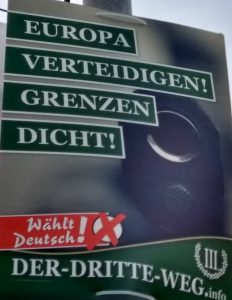
“Defend Europe – close the borders”. This one is a bit of disappointment. First, why defend “Europe”? Sure, there is the blackboard-style font which dropped out of favour in adverts ca 1955, urging as to “vote German”. There are also the oak leaves around the Roman numeral, but they are still in use by German authorities today. The silver-black thingy could be the muzzle of a gun or a surveillance camera or perhaps a modern take on the Volksempfänger radio. But all in all, the message is a bit too 21st century. So let’s move on.

This next first exhibit is much more exciting. We learn that the Third Way is both ‘national’ and ‘socialist’. So national-socialist. It does not get any clearer. And they are also ‘revolutionaries’ – all super obvious references to the ‘leftist’ wing of the Nazi movement. Extra points for the hammer/sword combination, which represents the unity of workers and soldiers. It was used, inter alia, by left-leaning Nazis and the Hitler Jugend. Then, in the 1990s, it was adopted by the autonomous neo-Nazi groups (“freie Kameradschaften”) from which the Third Way emerged. Unlike other extreme right symbols, its use is also legal in Germany.
Next is this one:
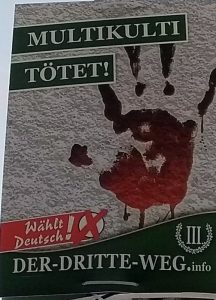
So: multi-culturalism kills. How exactly? Presumably by diluting the pure blood of the in-group. Because apparently, it also leaves bloody hand-prints on freshly painted walls. A very similar poster by the NPD (“immigration kills”) was banned by the authorities for inciting hatred. Presumably, the Third Way got away (hah!) because they were overlooked.
Speaking of reasons for banning, there is this one:
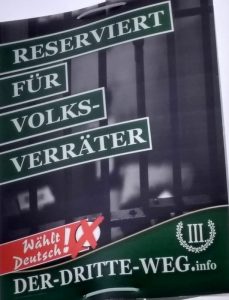
A picture of a prison cell that it reserved for “traitors of the people” – yet another term that was used by he Nazis to justify violence and murder. I was mildly shocked that they stopped at the German version of “lock her up” and refrained from depicting a gallows.
If you are equally shocked and also confused to who exactly the traitors might be, in a bid to clarify the situation they present a handy list of traitors that need to be stopped:
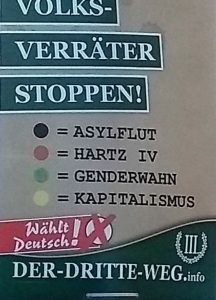
The dots refer to the colours usually associated with German parties. And so the CDU/CSU are traitors b/c “asylum flood”, the SPD introduced the “Hartz IV” flexicurity legislation, the Greens are behind “gender madness”, and the Liberals want to unleash capitalism. So they want to put almost anybody in prison. Somewhat surprisingly, the Left and the AfD were not given any attention, perhaps because the colour-in thing became too confusing?
Two questions remain. First, how are these guys legal? The short answer is that banning a party is complicated and risky, and so for the time being, they are kept under observation and members will be prosecuted individually for stuff like breaking the peace. Second, where are your youthful neighbourhood anti-fascists when you need them? I have no answer to that.
Discover more from kai arzheimer
Subscribe to get the latest posts sent to your email.
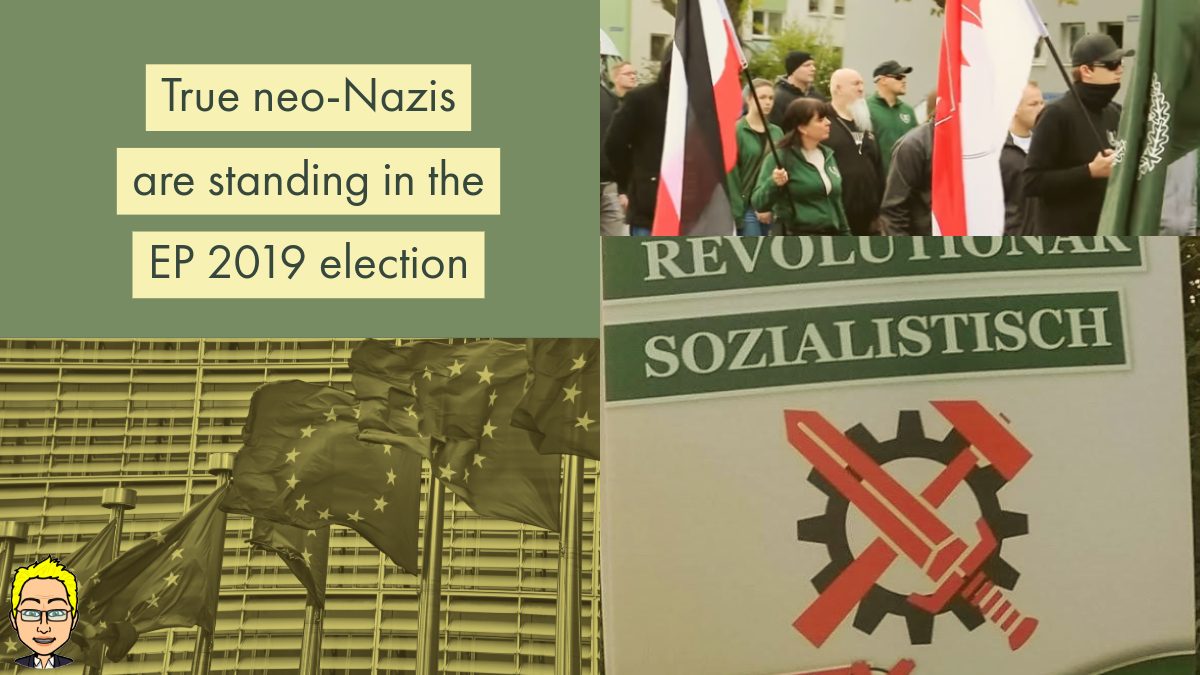


Dass nach der Einheit (und Demokratisierung der DDR) die juristischen und akademischen Teileliten aus dem Westen importiert wurden, ist klar. Welche Alternative hätte es auch gegeben?
Das eine Urteil in Chemnitz brauner Kontinuität zuzuschreiben, erscheint mir aber zu simpel.
Exactly, i know about the elite replacement in the East, as well as that in the West in the 1950s over 85% judges were the same as in 1940s. Suspect similar or higger number for law profs. So that is part of the elephant story for me.
ausschließen aus dem Westen rekrutiert wurden (und das gleiche galt natürlich auch für Jura-Profs im Osten). Zumindest für die (jetzt) älteren Jahrgänge würde ich deshalb keine großen Ost-West-Unterschiede erwarten
The beauty of democratic pluralism is, we are free to disagree. I respect your point and hope there will be a broad socital discussion on this. Happy to be proven wrong.
Wörtlich genommen sind wir im Osten wie im Westen mindestens drei Elefantengenerationen weiter. Was dabei an Mentalitäten weitergereicht wurde, wäre interessant zu wissen. Aus den frühen Elitenstudien weiß allerdings, dass in den 90ern über Jahre Richter und Staatsanwälte 1/2
Letzteres ist mir etwas (zu) pauschal. Und gerade in Chemnitz (ehemals Karl-Marx-Stadt) kommt das mit den 70 Jahren nicht hin.
While I understand the despair and emphasize. I also believe sunlight is the best disinfectant. The brown elephant in has been in the judiciary for over 70 years.
Here is a statement by a colleague from the @uniGoettingen law faculty inspired by that ruling. He is close to despair. @PetraGuasti
twitter.com/hmheinig/statu…
RT @kai_arzheimer: Little show of horrors: 5 election posters by one of the nastiest & most marginal parties competing for seats today http…
RT @kai_arzheimer: Little show of horrors: 5 election posters by one of the nastiest & most marginal parties competing for seats today http…
RT @kai_arzheimer: Little show of horrors: 5 election posters by one of the nastiest & most marginal parties competing for seats today http…
RT @kai_arzheimer: New blog – The EP 2019 brings all the (neo-fascist) boys to the yard – kai arzheimer https://t.co/ZzmHQGAY2E #EP2019 #Ge…